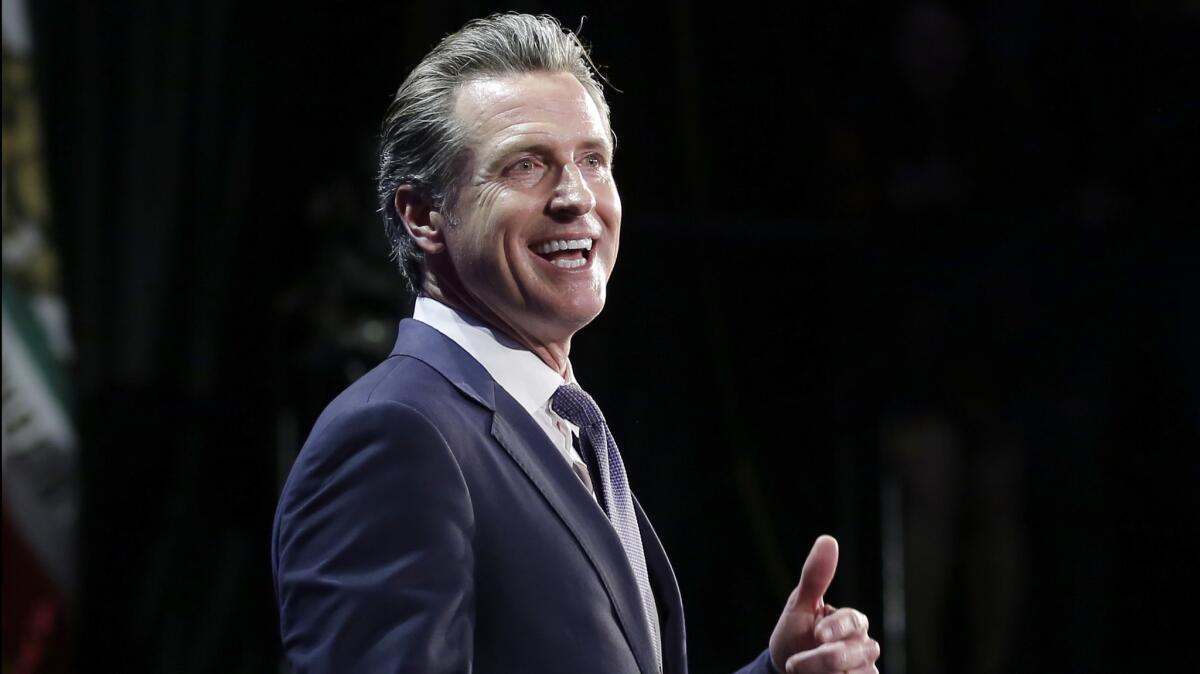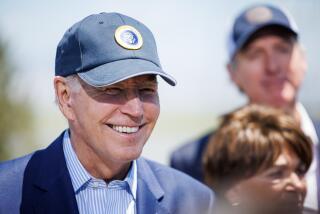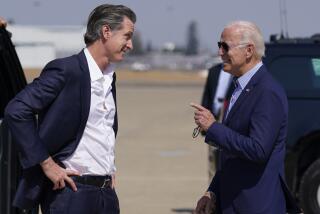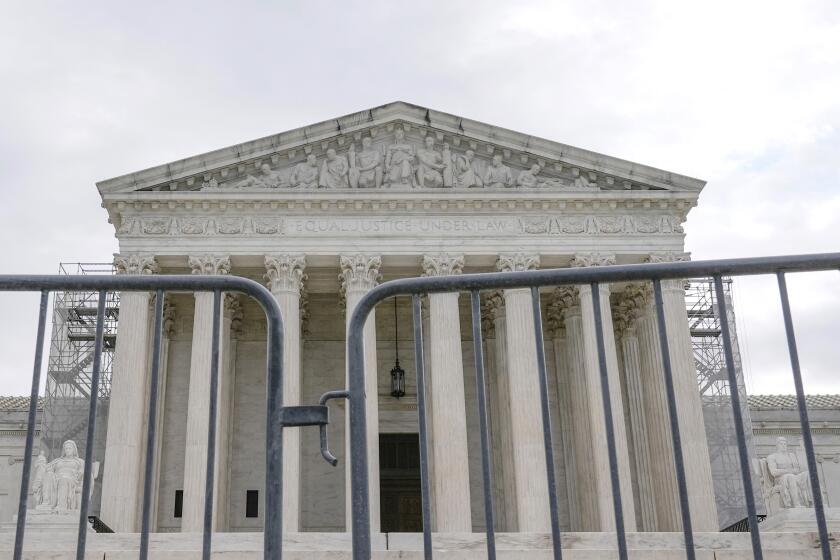Analysis: A new Democratic governor must decide how far he wants to lead California to the left

Few can argue with California Democrats that their sweeping victories Tuesday are a clear mandate to set in place an agenda for the state that will last well into the next decade. Less clear, though, is what those marching orders should be — and whether voters will embrace the full panoply of demands that have lurched the state’s dominant party leftward since the election of President Trump.
No one will face that task more directly than Gov.-elect Gavin Newsom. With his resounding victory over Republican challenger John Cox, the 51-year-old Democrat not only will preside over the nation’s largest economy, but as leader of America’s most fierce resistance to Trump and the nationalist shift of mainstream GOP politics.
But the history of how Democrats came to dominate California politics over the last quarter-century is a story less about provocation than pragmatism. The majority of the state’s modern-era governors have been Republicans. Newsom’s platform was hardly one of a centrist, even though the state’s electorate has rarely been as liberal as its national reputation — choosing instead to be socially moderate but fiscally stingy, environmentally progressive but solidly behind get-tough-on-crime efforts.
No one knew that chapter of California’s political life better than the man Newsom will replace in January, Gov. Jerry Brown.
The cliche that has followed Brown for decades is his “canoe theory” of politics, a belief that paddling a little on the right and then on the left ensures the vessel of government steers in a straight path. Few leaders could pull off a multibillion-dollar expansion of Medi-Cal while at the same time coming across as a frugal guy who canceled state worker cellphones and stashed money in a rainy-day fund.
Conservatives never thought the iconic Democrat was all that straight in his paddling. But Brown’s approach stood the test of time; public opinion polls consistently found a majority of voters liked the way he handled the job these last eight years.
Newsom, in contrast, made his campaign slogan “Courage for a change.” It came across as equal parts swagger about the path forward and a not-so-subtle rejection of what came before. If the governor-elect intends to recalibrate that bold promise in the weeks and months to come, he didn’t offer any hints Tuesday night.
“The sun is rising in the west, and the arc of history is bending in our direction,” he said to supporters at a crowded Los Angeles victory party. “This is not just a state of resistance. California is a state of results.”
Newsom, only the third California lieutenant governor in the last 70 years to win the top job, must quickly focus on the practical. Gubernatorial transitions are a dive into the deep end of the pool, with state budget decisions that must be made — in consultation with Brown — in a matter of weeks, long before Newsom takes the oath of office.
The new governor also may have to contend with the other Democrats elected to statewide office Tuesday, each seeking a platform to demand change. Most of them, like Newsom, will be new to the job. None ran on a platform of moderation.
In Sacramento, they will join a California Legislature where Democratic leaders have spent two years pushing forward an agenda that has become the nation’s most persistent repudiation of Trump. That effort remains largely intact, thanks to Brown’s signature on a series of environmental and immigration laws. The president has largely ignored the state, although his administration unsuccessfully asked the courts to block the “sanctuary state” immigration enforcement law enacted this year.
Brown has only occasionally criticized the president, often sounding a note of indifference to any taunt from Trump about the state’s actions. “We can follow our own trajectory,” he told reporters Wednesday. “I would rather focus on the creativity and the unique opportunities and needs of California, as opposed to defining everything in relationship to the president.”
Newsom has been far less restrained. He didn’t reference Trump by name on Tuesday, only by reputation. “It’s been a long two years, but tonight America’s biggest state is making America’s biggest statement,” he said. “We are saying — unmistakably and in unison — that it’s time to roll credits on the politics of chaos and cruelty.”
Nor has the governor-elect held back in his embrace of ideas that embody the base of his Democratic Party. No topic looms larger on that score than universal healthcare — Newsom has insisted, as he did during a candidates’ forum last year, that “single-payer is the way to go to reduce costs and provide comprehensive access.”
So will he lead an effort in 2019 or beyond to revive a stalled attempt in the Legislature to do just that? The party’s base may demand it, a test for Newsom in his early days as governor. The topic was a key point of contention during the 2018 primary, when former Los Angeles Mayor Antonio Villaraigosa said the proposal floating around the statehouse in 2017 was nothing more than “snake oil,” lacking the details necessary to be taken seriously.
Newsom snapped that his fellow Democrat was nothing but a “defeatist” on the issue. Should he call for patience as governor, he will surely hear the same criticism from progressives. Other topics also will be tricky, as Democratic legislators are eager to push bills vetoed by Brown onto the desk of the new governor. Higher education officials, meanwhile, say they intend to demand more college funding in 2019.
Here too the question arises: How progressive is too progressive? Legislative Republicans may play a small role, but they will be all too happy to sound the alarm in hopes of resetting at least part of the state’s political narrative by 2020.
The relationship between new governors and legislators is often contentious. Former Gov. Gray Davis, fresh from a 20-percentage-point victory in 1998, boasted to a newspaper editorial board that the Legislature’s job was “to implement my vision.” Five years later, facing a recall by voters, Davis eagerly signed a handful of liberal-leaning bills in an unsuccessful effort to rally turnout among the party’s base.
Unlike Brown, who was governor before some current legislators had even been born and received a lot of deference from his fellow Democrats, Newsom will probably be seen as the newcomer. He may have an office in the historic Capitol building, but his post for the last eight years has been more understudy than a starring role. The leaders of the Senate and Assembly, on the other hand, will reprise their roles from the last few years. And most legislators who will serve alongside the new governor can remain in office beyond his four-year term.
“Every new governor going in with an established legislative leadership, there’s a little bit of a question of how power is shared,” said John A. Perez, a former Assembly speaker. But the governor, he acknowledged, has real power in shaping the state’s budget — key leverage over programs championed by liberal Democrats.
Newsom may look to Brown’s track record for guidance, one he praised on the campaign trail. “You do not need to be profligate to be progressive,” he told a San Francisco audience in 2016.
How he’ll translate that slogan into substance remains to be seen. Had Villaraigosa, not Republican John Cox, emerged in second place in the June primary, voters might have had a front-row seat to a robust debate about Democratic or centrist-left public policy, one that could have better defined how Newsom will thread the needle of Democratic politics.
But in Cox, there was only the tried-and-true Republican brand — one rejected by voters on the statewide level for more than a decade.
“He wasn’t going out of his way to try and meet Californians where they are at,” said Assemblyman Chad Mayes (R-Yucca Valley), a leader of a political action committee that is trying to reimagine GOP politics. “If you have a scarlet ‘R’ next to your name, you can’t win statewide.”
In Mayes’ assessment is a question that this election, like those in 2014 and 2010, failed to answer: Do Democrats dominate California politics because of the strength of their positions, or because of the absence of centrist Republicans? Few elected officials will have more of a role in answering that question than Newsom.
Unlike Brown, who oversaw the final touches on fixing many of the leftover problems from California’s 20th century, the new governor seems poised to be its first leader of what’s ahead. Along with the others who will take office in January, he is not only part of a new chapter for the state, but also represents a different brand of Democratic politics crafted during a time when choosing sides has sometimes taken precedence over building bridges. How he responds as the party’s leader — and as the governor of millions who don’t always agree with him — will be a key test.
Times staff writer Melanie Mason contributed to this report.
Follow @johnmyers on Twitter, sign up for our daily Essential Politics newsletter and listen to the weekly California Politics Podcast
UPDATES:
12:59 p.m.: This article was updated with comments from Gov. Jerry Brown and additional details.
This article was originally published at 3:00 a.m.
More to Read
Get the L.A. Times Politics newsletter
Deeply reported insights into legislation, politics and policy from Sacramento, Washington and beyond. In your inbox three times per week.
You may occasionally receive promotional content from the Los Angeles Times.







